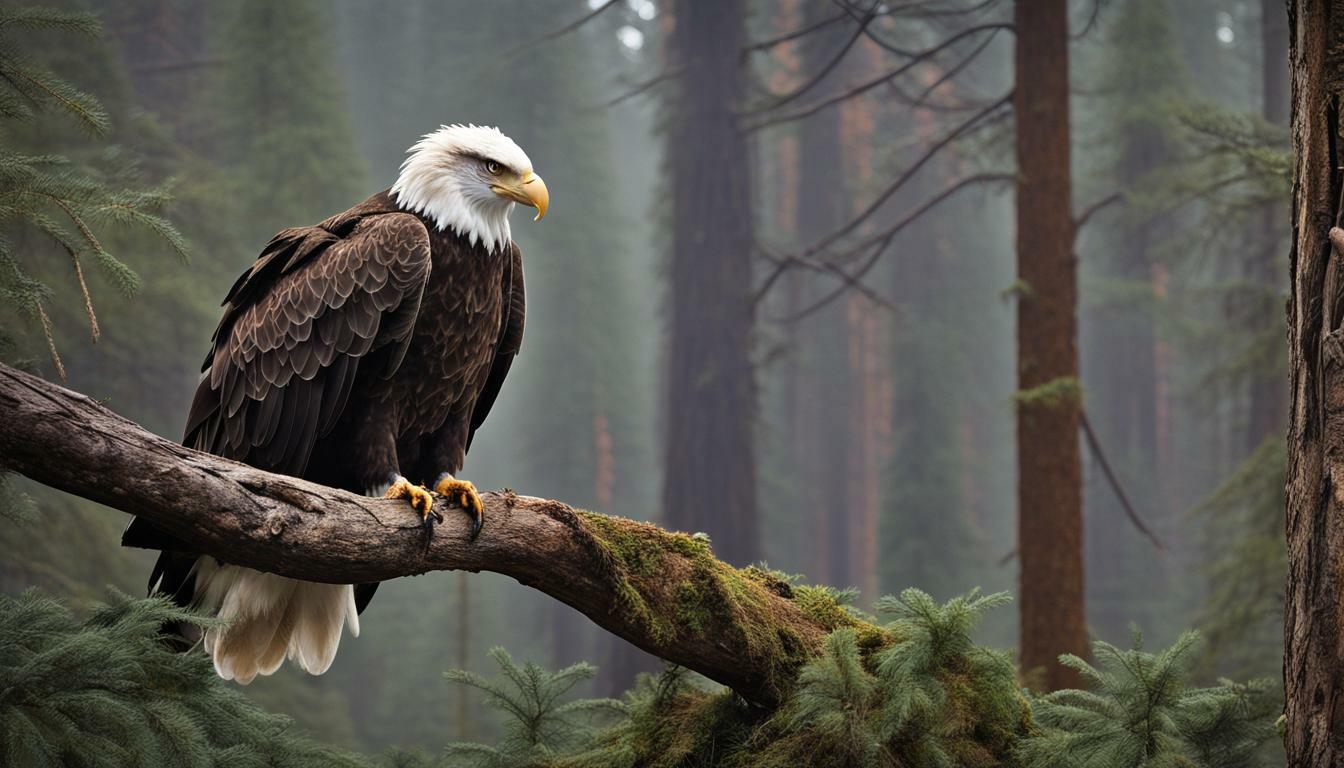If you’ve ever seen a bald eagle soaring through the sky, you know just how majestic these birds can be. With their fierce talons and sharp beaks, they seem almost invincible. But even the mighty bald eagle has to contend with predators. So how do they protect themselves?
Key Takeaways:
- Bald eagles face threats from predators like other birds of prey, raccoons, and foxes.
- They have developed various adaptations to defend themselves, including strong beaks, sharp talons, exceptional eyesight, and swift flight.
- Bald eagles use a variety of strategies to protect themselves, such as nesting habits, territorial behavior, and cooperative defense.
- They also employ specific defense mechanisms like vocalizations, dive-bombing, and aggressive displays.
- In addition to defense, bald eagles use avoidance and deterrence techniques to keep predators at bay.
- Even with all these strategies, human activities like hunting and habitat destruction can still pose a threat to bald eagles.
Predators of Bald Eagles
As majestic and powerful as bald eagles are, they are not invincible. Like all animals, they have natural predators that pose a threat to their survival. These predators are both terrestrial and aerial, and they target different life stages of the bald eagle.
Some of the most common predators of bald eagles include other birds of prey such as golden eagles, great horned owls, and peregrine falcons. These aerial predators will attack eagles in flight, or when they are perched, resting, or feeding.
Terrestrial predators such as raccoons, foxes, and coyotes, target bald eagles when they are nesting, or when they are on the ground searching for food. These predators are known to raid the eagle’s nests, steal their eggs, or kill their young.
Even human activities such as hunting and habitat destruction have a significant impact on bald eagle populations. Before bald eagles were granted legal protection in the United States, they were hunted for sport or killed as a perceived threat to livestock. Habitat destruction resulting from urbanization, industrial activities, and deforestation also reduces the eagles’ available nesting sites and prey, placing additional pressure on their populations.
Bald Eagle Anti-Predator Adaptations
As a bald eagle, you have developed an arsenal of impressive adaptations to protect yourself from predators. Your powerful beak and razor-sharp talons are your primary weapons, allowing you to seize prey and defend yourself against attackers.
In addition to your physical traits, your keen eyesight is essential for spotting potential predators from great distances. You can see prey up to two miles away, and your eyes are specially adapted to detect movement, making it more challenging for predators to sneak up on you.
Your wings are also an essential tool for evading predators. You are a skilled flyer, capable of reaching speeds of up to 40 miles per hour, and you can quickly maneuver through the air to avoid threats and pursue prey.
Finally, your natural instinct is to keep a low profile and avoid drawing attention to yourself. You use camouflage techniques, such as choosing nesting sites that blend in with your surroundings, to stay hidden from potential predators.
Bald Eagle Protection Strategies
Now that you know the predators that threaten bald eagles, let’s explore the strategies they use to protect themselves. One key approach is their nesting habits. Bald eagles build their nests high up in trees or on cliffs, making it difficult for predators to reach their young. They also often choose nesting sites close to bodies of water, where they can quickly retreat if necessary.
Bald eagles are also territorial birds and establish large territories for themselves and their offspring. They will aggressively defend their territory from intruders, including potential predators. This territorial behavior can be a powerful deterrent to predators that may be considering attacking.
Another tactic bald eagles use is cooperative defense. They will work together to defend themselves, their nests, and their young from predators. This can involve both vocalizations and physical displays to drive predators away or scare them off.
Finally, bald eagles can also use their size and strength to intimidate predators. They are powerful birds with sharp talons and strong beaks, and they are not afraid to use them if necessary.
Bald Eagle Predator Defense Mechanisms
When faced with predators, bald eagles have developed several defense mechanisms to protect themselves. These strategies are a testament to their remarkable survival skills and are a source of fascination for bird enthusiasts.
Vocalizations
One of the most common defense mechanisms of bald eagles is their ability to vocalize. They emit loud calls to warn off predators, attract other eagles for backup, or signal their territory. These calls are often heard during breeding season, but they are also used to communicate with other eagles at any time.
Dive-bombing
Bald eagles are skilled aerial hunters and use this ability to their advantage when being threatened by predators. They will often fly high above the predator and then dive-bomb it, using their sharp talons to attack and deter the predator.
Aggressive displays
Bald eagles are known for their aggressive behavior, especially when defending their nests and young. They will often spread their wings wide and puff up their feathers to appear larger and more threatening to predators. They may also fly around the predator, making loud calls and swooping towards it to intimidate it.
Additional Strategies
In addition to these defense mechanisms, bald eagles also use other strategies to protect themselves from predators. For example, they often nest in hard-to-reach places, such as high up in trees or on tall cliffs. They also exhibit territorial behavior, where they mark their territory and defend it from intruders. Finally, they may employ cooperative defense, where multiple eagles work together to protect themselves and their young.
Bald Eagle Predator Avoidance
If you want to know how bald eagles protect themselves from predators, it is essential to understand their avoidance strategies. These magnificent birds tend to choose nesting sites that are far from potential predators, such as human activities and places where other large birds of prey are not prevalent.
Bald eagles also use camouflage techniques by blending in with their surroundings, making it difficult for predators to spot them. If a predator is approaching, bald eagles will retreat to higher or inaccessible perches, where they can observe the situation and determine the best course of action.
Bald Eagle Predator Deterrence
If a predator approaches your nest, you’ll need to deter it. Bald eagles use a variety of deterrents to drive predators away. One such method is mobbing. By joining forces with other birds, bald eagles create a commotion that alerts other animals to a potential predator’s presence. This tactic can intimidate or confuse the predator and make it think twice about sticking around.
Bald eagles also engage in threat displays, where they extend their wings, arch their backs, raise their feathers, and make aggressive calls. This behavior can scare off predators and signal that the eagle is not an easy target. If a predator doesn’t get the message and approaches too closely, the bald eagle may resort to dive-bombing. This involves swooping down at high speeds toward the predator, often accompanied by loud screeching. The purpose of dive-bombing is to intimidate the predator and make it flee.
If all else fails, bald eagles are not afraid to engage in direct confrontation. Using their strong talons and sharp beaks, they will fight fiercely to defend themselves and their young.
Bald Eagle Self-Defense
When faced with a direct threat from a predator, bald eagles have a few self-defense mechanisms at their disposal. Their strong beaks and sharp talons can be used to fight back and defend themselves.
In some cases, bald eagles will use their talons to grab onto the predator’s body and hold on tightly, preventing the predator from getting away. They may also use their beaks to strike the predator, causing injury and allowing the bald eagle to escape.
It is worth noting, however, that bald eagles typically only use these self-defense mechanisms as a last resort. Whenever possible, they will rely on other defense strategies like predator avoidance, deterrence, and cooperative defense to protect themselves and their nests.
Bald Eagle Predator Defense Strategies
As a bald eagle, protecting yourself from predators is vital to your survival. In addition to the physical adaptations that help you defend against attacks, you also employ various defense and deterrence strategies to protect yourself.
Territorial behavior
You are territorial birds and will defend your nesting area aggressively, especially during breeding season. You use sharp vocalizations and aggressive displays to warn potential predators to stay away.
Aggressive displays
When threatened by a predator, you may use aggressive displays to intimidate them and prevent an attack. You spread your wings wide, puff up your feathers, and make sharp vocalizations to show your strength and size.
Mobbing
You also use mobbing as a strategy to deter predators. When you spot a potential threat, you join forces with other birds, like crows or seagulls, to harass and chase away predators.
Size and strength
Finally, your sheer size and strength can be intimidating to some predators. You are powerful birds, with a wingspan of up to seven feet and sharp talons that can cause serious injury. In some cases, simply showing your strength can be enough to deter predators from attacking.
Bald Eagles vs. Human Predators
Although bald eagles have a range of predators in the wild, human activities also pose a significant threat to their survival. Hunting and habitat destruction can harm bald eagle populations and disrupt their ecosystems. With their declining numbers, it is crucial to protect these majestic birds from human predators and preserve their natural habitats.
Conclusion
Congratulations! You now know how bald eagles protect themselves from predators. From their powerful beaks and talons to their exceptional eyesight and swift flying abilities, bald eagles have developed remarkable adaptations and strategies to safeguard themselves. They employ various defense mechanisms, including vocalizations, aggressive displays, and dive-bombing. They also avoid predators by selecting their habitats carefully, using camouflage techniques, and retreating to higher perches.
It’s important to appreciate these survival tactics of bald eagles, as they play a crucial role in maintaining a healthy ecosystem. We must also recognize the impact of human activities, such as hunting and habitat destruction, as potential predators of these majestic birds. By learning more about how bald eagles protect themselves from predators, we can help protect and preserve their populations for generations to come.
Does the Speed at Which a Bald Eagle Dives Help It Defend Itself from Predators?
Does the speed at which a bald eagle dives help it defend itself from predators? The answer lies in understanding just how fast can a bald eagle dive. With astonishing agility, a bald eagle can reach speeds of up to 100 miles per hour during its dive, enabling it to evade potential threats swiftly and effectively. This remarkable speed not only allows the bald eagle to surprise its prey but also serves as a powerful defense mechanism against predators lurking nearby.
FAQ
Q: How do bald eagles protect themselves from predators?
A: Bald eagles have several ways to protect themselves from predators. They have strong beaks and sharp talons that they can use for defense. They also have exceptional eyesight, which allows them to spot danger from a distance. Additionally, bald eagles are skilled flyers and can quickly escape from potential threats.
Q: What are the predators of bald eagles?
A: Some of the predators that pose a threat to bald eagles include other birds of prey, such as owls and hawks. Raccoons and foxes are also known to prey on bald eagle eggs and nestlings.
Q: What adaptations do bald eagles have to protect themselves from predators?
A: Bald eagles have developed several adaptations to protect themselves from predators. These include their strong beaks and sharp talons, which they can use to defend themselves. They also have exceptional eyesight, allowing them to spot predators from a distance. Their ability to fly swiftly helps them escape from potential threats.
Q: What strategies do bald eagles use to protect themselves from predators?
A: Bald eagles employ various strategies to safeguard themselves from predators. They choose nesting sites in secluded areas, away from potential threats. They also exhibit territorial behavior, defending their nesting territories from intruders. Bald eagles may also engage in cooperative defense, where multiple individuals work together to protect their nests.
Q: How do bald eagles defend themselves against predators?
A: Bald eagles have specific defense mechanisms to protect themselves from predators. They use vocalizations to communicate and warn other eagles of potential dangers. They also perform dive-bombing maneuvers, swooping down towards predators to intimidate and drive them away. Bald eagles may also display aggressive behaviors, such as spreading their wings and making threatening gestures.
Q: How do bald eagles avoid predators?
A: Bald eagles have several ways to avoid predators altogether. They carefully select their habitats, choosing areas with ample food sources and suitable nesting sites away from potential threats. Bald eagles also use camouflage techniques, blending into their surroundings to remain hidden from predators. They have the ability to quickly retreat to higher or inaccessible perches, making it difficult for predators to reach them.
Q: How do bald eagles deter predators?
A: Bald eagles deter potential predators through various behaviors. One tactic is mobbing, where they join forces with other birds to harass and drive away predators. By mobbing together, they increase their collective strength and make it clear to predators that they are not an easy target.
Q: How do bald eagles defend themselves when directly threatened?
A: When directly threatened by predators, bald eagles can defend themselves using their powerful beaks and talons. They will fight back and use their size and strength to intimidate their attackers. Bald eagles are not afraid to stand up for themselves when their safety is at risk.
Q: What other defense strategies do bald eagles use against predators?
A: In addition to their physical abilities, bald eagles employ other defense strategies against predators. They exhibit territorial behavior, vigorously defending their nesting territories. Bald eagles also display aggressive postures and behaviors, such as puffing up their feathers and making threatening displays, to intimidate potential predators.
Q: Do bald eagles have human predators?
A: While bald eagles primarily face threats from other animals, human activities can also impact their survival. Hunting and habitat destruction have been significant challenges for bald eagles in the past. However, conservation efforts have helped protect and restore their populations.










